
The summer of 2022 was tough for farmers in the American West: Hot, dry conditions led snow to melt early, reservoirs to run low and streams to pare down to mere trickles. For many, that meant less water to grow crops and reduced yields. But Byron Kominek, a farm manager near Longmont, Colorado, enjoyed an abundant harvest of peppers, tomatoes, squash, and lettuces.
When his family farm stopped making a profit, Kominek installed solar panels on the plot and invited Sprout City Farms to grow crops beneath them. It’s a setup known as agrivoltaics—where solar panels and agriculture occupy the same land—and the duo effectively harvests the sun twice, for both food and electricity.
Protected from the high midday sun, plants under panels become mini swamp coolers: As they open their pores to photosynthesize, water escapes from their leaves—creating a cooler microclimate. This reduction in heat increases the efficiency of the panels—even as the panels are sheltering the crops beneath from overexposure to the hot sun. Consequently, agrivoltaics can provide benefits to both farmers and electricity producers. In the past few years another possible advantage has come to the fore: crops grown under panels need less water.
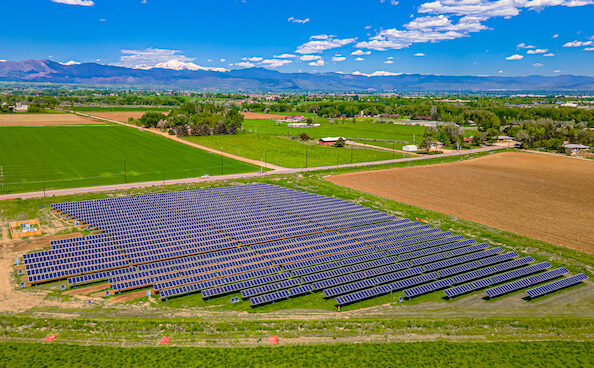
“If you spilled your water in the shade versus the sun, where would it stay wet longer?” asks Greg Barron-Gafford, a University of Arizona professor who has helped set up the site as well as experimental agrivoltaic plots in Arizona, Africa, and Israel.
At one such site, Biosphere 2 near Oracle, Arizona, Barron-Gafford has found that some crops beneath solar panels only need watering every couple of days, compared to every few hours for those grown in direct sunlight. Agrivoltaic cherry tomatoes proved 65% more water efficient than those grown under an open sky, for example, and the total fruit production doubled. Researchers are now scrutinizing how different spacings of panels are impacting the water needs of a range of crops in the hot, dry climate of the Sonoran Desert.
Meanwhile, at Kominek’s farm, now called Jack’s Solar Garden and the largest commercially active agrivoltaics system in the United States, the same scientists are testing which crops thrive under panels in the varied seasons of Colorado.
Barron-Gafford believes agrivoltaics could help farmers in the West who want to keep farming in the face of climate change. “We want to adapt our food system to survive through periods of drought and warmer temperature changes, and that comes down to easing our dependence on irrigation,” he says.
Harvest hacking
Against the backdrop of Sonoran Desert scrub on a sunny but chilly November morning, Nesrine Rouini tends to seedlings under a canopy of solar panels at the Biosphere 2 site. A mere 9- by 18-meter (30- by 59-foot) garden, the experimental agrivoltaics site resembles an intensive care unit for plants—stakes bearing barcodes identify each new sprout, and a network of cables and wires runs along each seedbed to a centralized data logger. This Gordian knot of leads and controls transmits real-time data of a plant’s living environment—soil moisture, temperature, solar radiation and a host of other variables—hour by hour to the research group in Tucson. Simultaneously, cameras track its growth from seedling to sprouting to flowering. A plant can’t so much as open a stoma without its actions being spotted, relayed and recorded.
Once a week, Rouini, an agrivoltaics researcher on Barron-Gafford’s team, visits the site and a control plot, which is not under panels. Using a handheld gas exchange device, she takes the pulse of each plant and checks how well it’s coping with the shade or open sky. “This is how we found out that plants in the control plot experience midday depression and don’t photosynthesize,” Rouini says. “While the ones under the panels keep trucking along.”
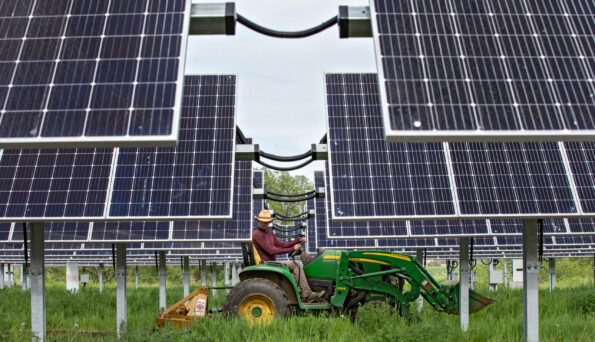
Irrigation on both plots starts at 7 a.m. By 9 a.m. the control plot soil already appears drier to the naked eye than earth under the panels. “Without shade the water just evaporates so much quicker,” Rouini says.
Basic physics dictates that crops grown under panels need less water, but scientists still don’t know how each crop will fare in each location and exactly how much water will be saved. Consequently, in Arizona, Colorado and a network of nearly 30 sites around the country, groups of researchers are trying to close that data gap.
Although scientists have studied the interaction between light and plants for decades, the novel shading regime of solar panels presents many unknowns, says Jordan Macknick, the lead energy-water-land analyst for the National Renewable Energy Laboratory and the principal investigator of the Innovative Solar Practices Integrated with Rural Economies and Ecosystems (InSPIRE) network of agrivoltaic sites. “The Holy Grail would be for any farmer to be able to pick a point on a United States map and retrieve information about what crops they could grow, the best configuration of panels and how much water they need,” he says.
Focusing on feasibility
In Colorado, Liza McConnell, Jack’s solar research farm manager with Sprout City Farms, observed that the lettuces grown with half the amount of water administered to a control plot were only a little smaller and significantly sweeter than their sun-exposed equivalents. Celery, typically a high-water-use crop, also fared well under a reduced watering regime, as did smaller peppers, but the larger Anaheim peppers under panels didn’t produce as much fruit as hoped. With the West in a prolonged drought and climate change taking its toll, people might have to adapt to not getting the exact type of pepper they want all year round McConnell says.
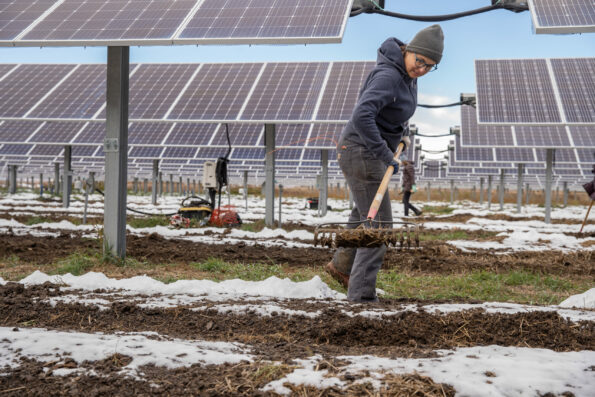
“In the face of climate change we need all options on the table,” she says. “Agrivoltaics is not the only solution, but it is going to be one of the things that will help keep our communities safe and resilient.”
Despite its many benefits, agrivoltaics may not be feasible for large-scale, single-crop farms that grow corn and soybeans and rely on using heavy machinery. Farming under solar panels is even challenging for farmers on their feet: McConnell equates it to farming on an obstacle course. On the flip side, the panels provide much needed shade for farmers on hot days.
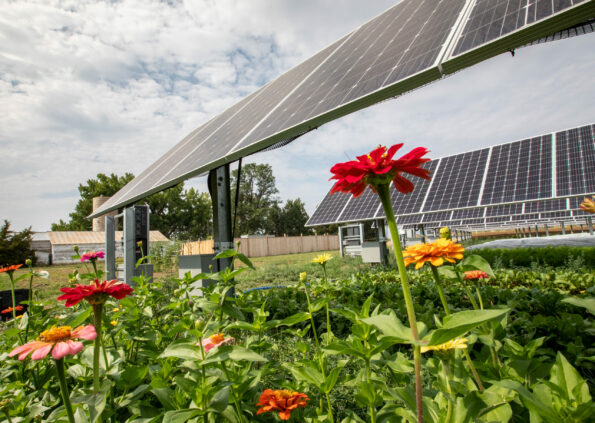
“We’re producing energy, we’re producing food, we’re conserving water, and we’re building soil health that further conserves water and nutrients,” McConnell says. “And then we’re also protecting necessary human labor and quality of life for farmworkers.”
The yield of certain crops, specifically warm-season peppers and tomatoes, might also be less under panels in Colorado, McConnell says. But these fruits only ripen at certain temperatures; if it’s too hot, they won’t ripen at all. “So a reduced yield is still better than having no tomatoes in the face of climate change,” she says.
Macknick points out that the revenue that farmers can make by selling solar-generated power will more than compensate for any reductions in farm produce and that agrivoltaics could help farmers in the West and the Colorado River Basin be more financially resilient to droughts and climate change.
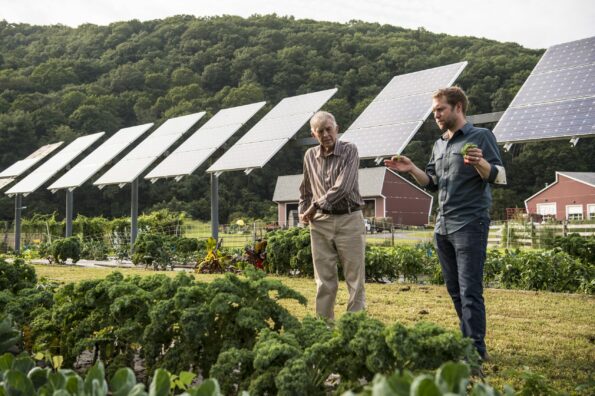
Another potential benefit of agrivoltaics is that it could open more land to farming, including Indigenous lands where food security and energy access have been issues. In hot and dry desert lands, for example, growing crops under panels can reduce the need for scarce water and increase productivity and feasibility for farming efforts. “Can some of these places now produce food because we’ve taken off that harsh edge of the environment?” Macknick poses.
Agrivoltaics also offers the potential to harvest and store rain so it can be used for irrigation. Gutters attached to the bottom of solar panels can capture rain and channel it into small reservoirs. But challenges exist in the execution. In Tucson, for example, water simply flows off water panels and gets wasted. “It would be good to think about how to set up guttering on panels to collect water intentionally and do it the right way,” Barron-Gafford says.
Large-scale agrivoltaics endeavors will face plenty of challenges, and they won’t be right for every farmer, Macknick says. But there’s potential to improve yields of some crops while enhancing soil health, reducing water needs and producing power, too. “It is certainly going to play a growing role in farming,” Macknick says. “I think we are going to see more and more of this.”
Weekly Newsletter
Get building science and energy efficiency advice, plus special offers, in your inbox.













2 Comments
This is an example of the sustainable growing of food. Just add seeds.
https://www.nativeseeds.org/blogs/blog-news/how-to-grow-a-three-sisters-garden
Doug
It seems like making dual use of the land is a no brainer. I understand that in the UK it is common to graze sheep under PV arrays in fields.
Log in or create an account to post a comment.
Sign up Log in